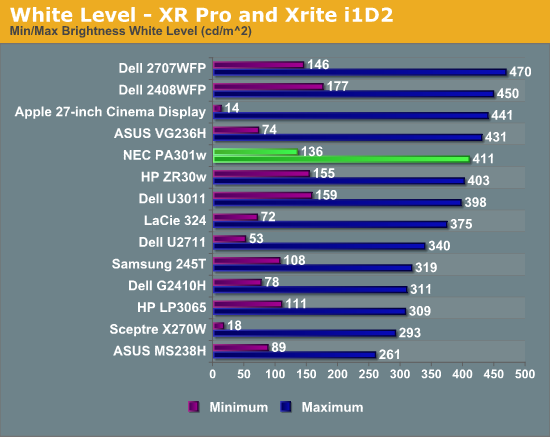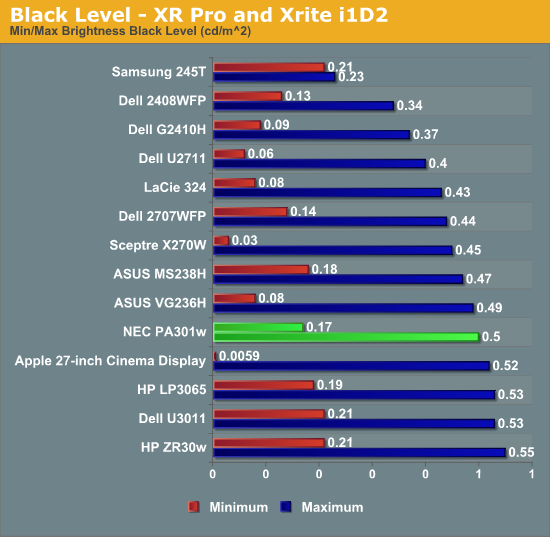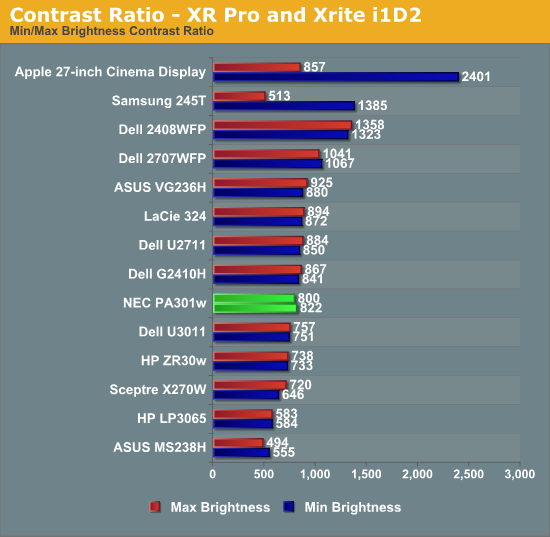NEC PA301w: The Baddest 30-inch Display Around
by Brian Klug on March 1, 2011 8:00 AM ESTBrightness and Contrast
For brightness, black level, and contrast points, we use the same colorimeter setup described earlier. Specifically, we use an Xrite i1D2 with ColorEyes Display Pro, and take measurements at maximum and minimum brightness of white and black targets. Dynamic contrast is turned off. We also let the panels settle in for a half hour at the respective settings before taking any measurements.
The PA301w uses a CCFL backlight, which makes that warm up time even more critical. The PA301w has an interesting quick warmup feature that reduces the visible brightness increase period dramatically. At power on, I measured brightness go from 160 nits (with the OSD showing 200 nits, blinking) to 210 nits in under one minute, then gradually settle to the desired 200 nits. There's a bit of overshoot, but the visual difference is hard if not impossible to actually pick out. For the sake of these tests, I waited for things to settle, but it's actually impressive how fast the PA301w can warm up to totally useable brightness levels.



Brightness settings in the OSD follow the same rules as color ones - if you select something impossible, the last changed value will show up pink, meaning it's outside of the monitor's capabilities. The same thing applies for brightness. I had no problem reaching 411 nits of brightness after getting that worked out - it's a similar thing I've seen on all other displays, sometimes you need to change contrast or color adjustment settings appropriately. Regardless, the PA301w went above the specified 350 nits of brightness, reaching 411. Contrast isn't quite the 1000:1 advertised typical, instead hovering around 800:1 pretty consistently.










92 Comments
View All Comments
63jax - Tuesday, March 1, 2011 - link
I'm also very curious about Samsung's PLS matrix. i also want to change my monitor with an IPS or PVA panel in 22'' range, but i'm really undecided. Maybe i will wait to see what PLS are capable of. Good review by the way, thanks.softdrinkviking - Tuesday, March 1, 2011 - link
At 22", you can get a lot of great quality LCDs for reasonable prices. If you can spend 300-400, I would go for IPS, if you want to stick closer to 200, you can get a VA screen from BenQ that is 23" widescreen and looks pretty good to me. The VA screens have between the viewing angles of the IPS and the TN, but without the color shift I noticed on TNs. When a VA goes out of view, it just looks dark, not pink or something weird like a TN.But I don't know how "calibration-friendly" VAs are. If photography is a concern for you, and you need the print to match the image in your screen, I think IPS is better.
This new samsung technology is anybodys guess, but I wouldn't get one until they have been put through the paces a bit and prove reliability.
NEC and LG have had a long time to work the kinks out of IPS, and it's widespread adoption in critical industries did not occur by chance.
eaw999 - Wednesday, March 2, 2011 - link
va's calibrate fine. many eizo's use va panels. but va panels have off-angle gamma shift, though, and it doesn't take a lot of angle to notice it. for me, anyway. this is most evident in darker shades. i tried an eizo monitor once and i couldn't stand watching movies on it because if i moved my head even slightly, shadow details would 'shimmer'. the only thing i liked about the eizo was that it had phenomenal black levels, as modern va panel usually do.legoman666 - Tuesday, March 1, 2011 - link
It's amusing to see that Anandtech staff run adblock+ on their own website.quiksilvr - Tuesday, March 1, 2011 - link
ROFL! Even they admit their adverts are annoying as hell.Stas - Wednesday, March 2, 2011 - link
lol. Sponsors won't be happy about that ^.^gc_ - Thursday, March 3, 2011 - link
I expect the advertisers paid for ads alongside articles, not for in-article placement. I expect advertisers also paid to have ads displayed during a certain period (say, a week or a month), not necessarily to have it display in-perpetuity in the archives. I don't know if AnandTech is syndicated and/or translated for different markets, but if it is, then if they included the ads they might have to redo the image for every market.DanNeely - Tuesday, March 1, 2011 - link
"Interestingly enough, the PA301w has a uniformity setting inside the OSD which defaults to 5 (maximum) and seems to definitely improve overall brightness uniformity and Delta-E consistency. Whatever secret sauce NEC has apparently works. "If this works the same way I think it does on the 3090, the internal LUT adjusts different parts of the screen differently to boost uniformity. I'd be curious what happens to it in 10bit mode though, since the 3090 did this by mapping 8 bit input to a 10bit panel/LUT.
DanNeely - Tuesday, March 1, 2011 - link
Should've looked at the specs before asking. The pa301w has a 14bit lookup table to use for onboard calibration/adjusting for screen variation.DanNeely - Tuesday, March 1, 2011 - link
Is this any better than in the multisync 90 series? The ones on my 2090/3090's were really flimsy and if you tried picking up the monitor the wrong way some of the tabs holding them on would snap off.